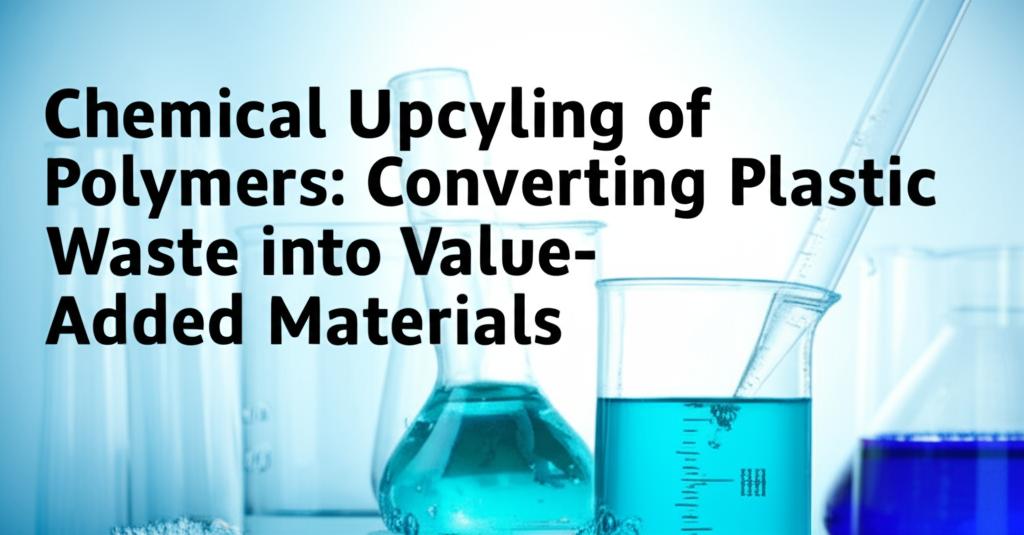Chemical upcycling represents a transformative approach to tackling the global plastic waste crisis, moving beyond traditional recycling methods that often result in lower-value materials (downcycling). Instead, it focuses on chemically converting discarded polymers into new, higher-value materials, chemicals, or fuels, effectively turning waste into a valuable resource. This strategy holds significant promise for establishing a more sustainable, circular economy for plastics.
Limitations of Conventional RecyclingTraditional mechanical recycling, while important, faces limitations. It often struggles with mixed or contaminated plastic streams, and repeated mechanical processing can degrade the polymer's properties, limiting the applications of the recycled material. Simple chemical recycling might recover monomers, but upcycling specifically aims to create products with enhanced functionality or economic value compared to the original plastic.
Core Chemical Upcycling StrategiesSeveral chemical pathways are being actively explored and developed to upcycle plastic waste:
- Depolymerization/Repolymerization: This involves breaking down polymers like Polyethylene Terephthalate (PET) or Polylactide (PLA) back into their constituent monomers or molecular building blocks using methods like solvolysis (using solvents), hydrolysis (using water), or alcoholysis (using alcohols). These purified monomers can then be repolymerized to create virgin-quality plastics or entirely new polymer structures.
- Pyrolysis: This thermal process heats plastics in the absence of oxygen (typically 400-800°C) to break them down into pyrolysis oil, gases (like syngas - a mixture of hydrogen and carbon monoxide), and char. Catalytic pyrolysis uses catalysts (like zeolites) to improve control over the product distribution, enabling the targeted production of fuels (like jet fuel or diesel), lubricants, or valuable aromatic chemicals. Emerging techniques like microwave-assisted pyrolysis offer alternative energy inputs.
- Hydrogenolysis and Hydrocracking: These methods use hydrogen and catalysts (often precious metals like platinum or ruthenium supported on materials like SrTiO3 or Nb2O5) to cleave the strong carbon-carbon bonds in polymers like polyethylene (PE) and polypropylene (PP). This can yield valuable products such as liquid fuels, lubricants, and waxes.
- Functionalization: Instead of complete breakdown, this strategy involves chemically modifying the existing polymer chains to introduce new functional groups. This approach can enhance the properties of the original plastic or create new materials with specific applications, such as adsorbents or catalysts, without significant polymer chain destruction.
- Conversion to Carbon Materials: Plastic waste, being rich in carbon, can be transformed into high-value carbonaceous materials like carbon nanotubes (CNTs), graphene, activated carbon, or carbon nanodots. These materials find applications in energy storage (electrodes), environmental remediation (adsorbents), and electronics.
- Emerging Techniques: Research is rapidly advancing in areas like photocatalysis (using light), electrocatalysis (using electricity), and enzymatic degradation (using biological enzymes) to break down or modify plastics under milder conditions, potentially offering more sustainable and energy-efficient routes.
- PET bottles can be chemically recycled back to terephthalic acid (TPA) and ethylene glycol (EG) monomers for new PET, or upcycled into fine chemicals, hydrogen, or other polymers like polyurethanes.
- Polyolefins (PE, PP), commonly used in packaging, can be converted via hydrogenolysis or pyrolysis into fuels, lubricants, waxes, or basic chemical feedstocks.
- Polystyrene (PS), found in packaging foam, has been upcycled into valuable chemicals like benzoic acid or converted into materials like polystyrene sulfonate (PSS) used in electronics and water filtration.
- Mixed plastic waste, often difficult to recycle mechanically, can be processed via pyrolysis or gasification into syngas or oils, or converted into carbon materials.
- Polycarbonates (BPA-PC) can be depolymerized into monomers and then potentially rebuilt into different, novel polymer materials.
The field is witnessing rapid advancements, particularly in catalyst development. Researchers are designing highly efficient and selective catalysts, including nanocatalysts and single-atom catalysts, to steer reactions towards desired products under milder conditions. Light-driven (photocatalytic) and electricity-driven (electrocatalytic) methods are gaining traction as potentially greener alternatives to high-temperature processes. There's also increasing interest in hybrid approaches, potentially combining chemical and biological methods. Functional upcycling, which modifies polymers without full degradation, is opening routes to advanced materials like adsorbents and electrode materials directly from waste.
Challenges and The Road AheadDespite its potential, chemical upcycling faces hurdles. Achieving cost-competitiveness with virgin plastics derived from cheap fossil fuels remains a significant challenge. Many processes are still energy-intensive, although efforts towards milder conditions are ongoing. Handling the complexity and contamination inherent in real-world plastic waste streams requires robust and versatile technologies. Scaling up promising lab-scale techniques to industrial viability requires substantial investment and technological refinement.
Nevertheless, chemical upcycling offers a powerful set of tools to redefine plastic waste as a feedstock for a new generation of materials and chemicals. Continued innovation in chemistry, catalysis, and process engineering, coupled with supportive policies and investment, will be crucial to unlock the full potential of chemical upcycling and drive the transition towards a truly circular plastic economy.

